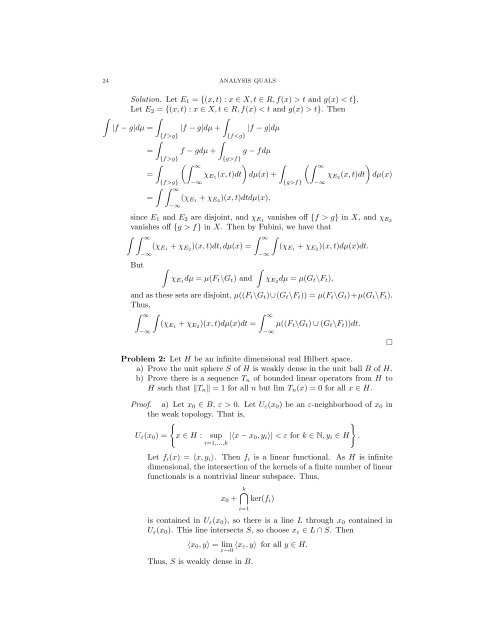ANALYSIS QUALIFYING EXAM PROBLEMS BRIAN LEARY ...
ANALYSIS QUALIFYING EXAM PROBLEMS BRIAN LEARY ...
ANALYSIS QUALIFYING EXAM PROBLEMS BRIAN LEARY ...
Create successful ePaper yourself
Turn your PDF publications into a flip-book with our unique Google optimized e-Paper software.
24 <strong>ANALYSIS</strong> QUALS<br />
<br />
Solution. Let E1 = {(x, t) : x ∈ X, t ∈ R, f(x) > t and g(x) < t}.<br />
Let E2 = {(x, t) : x ∈ X, t ∈ R, f(x) < t and g(x) > t}. Then<br />
<br />
<br />
|f − g|dµ = |f − g|dµ + |f − g|dµ<br />
<br />
=<br />
{f>g}<br />
{f>g}<br />
<br />
f − gdµ +<br />
{ff}<br />
g − fdµ<br />
∞<br />
<br />
=<br />
{f>g}<br />
∞<br />
χE1(x, t)dt<br />
−∞<br />
= (χE1 + χE2 )(x, t)dtdµ(x),<br />
−∞<br />
∞<br />
<br />
dµ(x) +<br />
{g>f}<br />
χE2(x, t)dt<br />
−∞<br />
dµ(x)<br />
since E1 and E2 are disjoint, and χE1 vanishes off {f > g} in X, and χE2<br />
vanishes off {g > f} in X. Then by Fubini, we have that<br />
∞<br />
∞ <br />
(χE1 + χE2 )(x, t)dt, dµ(x) =<br />
−∞<br />
(χE1 + χE2 )(x, t)dµ(x)dt.<br />
But <br />
χE1dµ = µ(Ft\Gt) and<br />
−∞<br />
<br />
χE2dµ = µ(Gt\Ft),<br />
and as these sets are disjoint, µ((Ft\Gt)∪(Gt\Ft)) = µ(Ft\Gt)+µ(Gt\Ft).<br />
Thus,<br />
∞ <br />
∞<br />
(χE1 + χE2)(x, t)dµ(x)dt = µ((Ft\Gt) ∪ (Gt\Ft))dt.<br />
−∞<br />
Problem 2: Let H be an infinite dimensional real Hilbert space.<br />
a) Prove the unit sphere S of H is weakly dense in the unit ball B of H.<br />
b) Prove there is a sequence Tn of bounded linear operators from H to<br />
H such that Tn = 1 for all n but lim Tn(x) = 0 for all x ∈ H.<br />
Proof. a) Let x0 ∈ B, ε > 0. Let Uε(x0) be an ε-neighborhood of x0 in<br />
the weak topology. That is,<br />
<br />
<br />
Uε(x0) =<br />
−∞<br />
x ∈ H : sup |〈x − x0, yi〉| < ε for k ∈ N, yi ∈ H<br />
i=1,...,k<br />
Let fi(x) = 〈x, yi〉. Then fi is a linear functional. As H is infinite<br />
dimensional, the intersection of the kernels of a finite number of linear<br />
functionals is a nontrivial linear subspace. Thus,<br />
x0 +<br />
k<br />
ker(fi)<br />
i=1<br />
is contained in Uε(x0), so there is a line L through x0 contained in<br />
Uε(x0). This line intersects S, so choose xε ∈ L ∩ S. Then<br />
〈x0, y〉 = lim<br />
ε→0 〈xε, y〉 for all y ∈ H.<br />
Thus, S is weakly dense in B.<br />
.
















